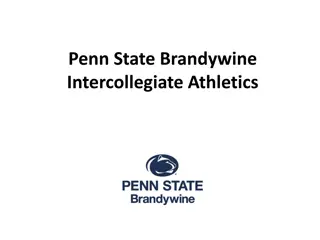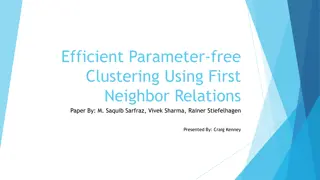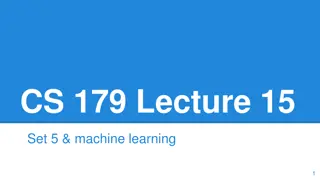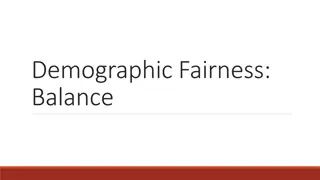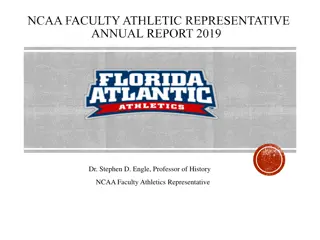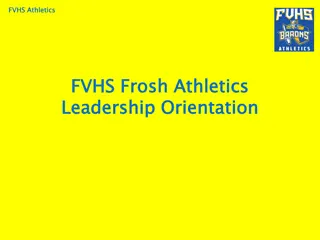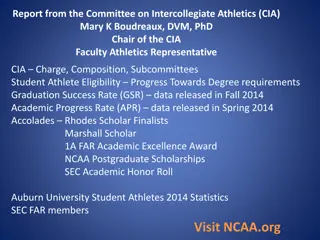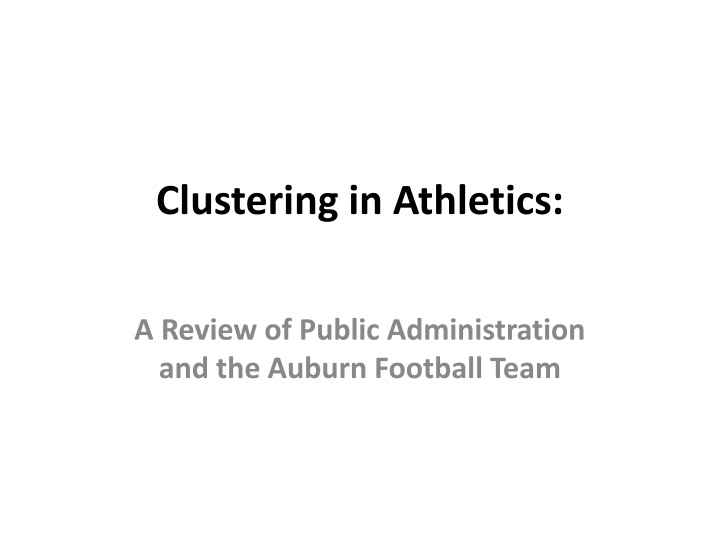
Review of Clustering in Athletics: Auburn Football Team Findings
Explore the investigation conducted by the Committee on Clustering in Athletics at Auburn University, examining the occurrence and reasons for clustering of athletes in majors compared to non-athletes, along with proposed causes and insights from peer institutions in the NCAA.
Download Presentation

Please find below an Image/Link to download the presentation.
The content on the website is provided AS IS for your information and personal use only. It may not be sold, licensed, or shared on other websites without obtaining consent from the author. If you encounter any issues during the download, it is possible that the publisher has removed the file from their server.
You are allowed to download the files provided on this website for personal or commercial use, subject to the condition that they are used lawfully. All files are the property of their respective owners.
The content on the website is provided AS IS for your information and personal use only. It may not be sold, licensed, or shared on other websites without obtaining consent from the author.
E N D
Presentation Transcript
Clustering in Athletics: A Review of Public Administration and the Auburn Football Team
Committee Information Provost forms an ad hoc committee (May 8, 2015) to To look into whether or not clustering of athletes in majors has occurred; To compare Auburn University to peer institutions; To look into reasons for why such clusters, if present, occur; And to make recommendations.
Committee Makeup Daniel Svyantek (Chair) Barb Struempler Brian Connelly Tina Loraas Mary Boudreaux Larry Teeter
Clustering Clustering is a grouping of a disproportionate percentage of athletes into selected majors when compared to the overall percentage of non-athletes in the same major Number of players on team with same major/total team players > 25% Number of junior senior players on team with same major/ number of junior and senior players > 25%
Clustering and NCAA Clustering in a major is not considered a violation of any rule by the NCAA FARs at FBS schools believe that clustering is function of NCAA own progress-toward degree requirement
Other Proposed Causes (McCormick, 2010) Student-athletes may be underprepared for some majors upon entry to college. Time management by athletes is critical to balance sports participation and classes. Preparation time for athletics may interact with the timing of offered classes (e.g., certain classes for some majors may not be taught at a time when athletes are able to take them). Different majors may have additional requirements for entry (e.g., a GPA requirement in college to become a major) which student-athletes may have difficulty meeting. College major choice may be, therefore, determined by academic performance in the athletes first year in college. Teammates may stick together (Fraternities) College major choice may be affected by the NCAA s 40-60-80 rule. Unrealistic career expectations (e.g., I am going to go pro!) may affect choice of major. Finally, student-athletes may receive favoritism in certain majors.
Clustering in Peer Institutions SEC (Upton and Novak, 2008) Auburn 26.5% in Criminology TAMU 51.5% In Ag Leadership and Development Vanderbilt 64% in Human and Organizational Development ACC (Fountain and Finley, 2009) 25% in Sport Administration to 73% in Bus Mgt Big 12 (Schneider, et al, 2010) 50% of players in one major related to ranking
Clustering at Auburn University Senate Meeting (May 19, 2015) 28 football players in PUBA 28/120 = 23% (no clustering) 23/48 = 48% (clustering)
Favoritism ?: Was favoritism shown towards athletes in PUBA Small sample Athletes received average grade of .94 < non- athletes 7/8 athletes received grades that could affect eligibility No evidence in sample Recommendation to do full analysis was made
Advising ?: Were athletes advised to take PUBA? Asked athletics representative, told no formal push to PUBA Asked athletics representatives, why go to PUBA PUBA seen as appropriate for careers in city, county, state or federal government Athletes talking to each other PUBA flexible and no quantitative course required Person-group fit and student profiles (unprepared, career-oriented)
Communication between Athletics and University officials ?: Was there communication between the athletic department and the university? Yes Did it alter decision? Alternative explanations exist consistent with administrative and organizational theory Organized anarchies Leader succession and strategic change
PUBA and money for program ?: Was money offered to PUBA to support program? Yes- offer seems to have been made University turned this offer down University has accepted money from athletics in past Consistent with practice at other universities (Arkansas, LSU, Kentucky)
Recommendations Publicize the support provided by Athletics to academics. Complete analysis of grading patterns in PUBA Time of course offerings should be looked into again Realistic career previews Create an Athletic Talons Annual Student-athlete and Student-Athlete Alumni Surveys Developing majors may be a possibility Utilize the Interdisciplinary Studies degree more effectively






